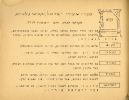The auction will take place on Monday, June 26, 2023, at 19:00 (Israel time) with an announcement.
Dear customers, an interesting and important catalog containing many rare and important historical items in the many fields in which we deal, we are happy for any question, inquiry, and delivery of all the necessary information beyond what is written in the catalog.
|
ЛОТ 155:
Non-traditional Haggadah. Kibbutz Beit Oren, 1941
далее...
|
|






|
Продан за: $220 (₪799)
₪799
Стартовая цена:
$
150
Комиссия аукционного дома: 23%
НДС: 18%
Только на комиссию
|
Non-traditional Haggadah. Kibbutz Beit Oren, 1941
Non-traditional Haggadah - Kibbutz Beit Oren 1941. Stencil print with illustrations. Many texts dealing with persecution of Jews - "The whole world is a burning stake for us!", the fate of the Jewish people in Europe, the struggle for Israeli independence, and Kibbutz Beit Oren itself.
At the beginning of the Haggadah, the text of "Nekadesh" mentions the troubles and events that the people of Israel are going through in this fateful year: "Savri the young people of Israel, exiles, we will sanctify this Passover, the memory of Israel's fallen in prisons in the Diaspora... Persecuted and expelled, shaken across lands and seas, seeking redemption". Further on the same page is a mention of the struggle for independence in Eretz Israel: "The blood of our pure friends, the martyrs of defense and operation, and those who fight for the honor of the people and the integrity of the land in the world's battles against the rule of evil."
The text of "Ma Nishtana" deals entirely with the plight of the Jewish people in all the countries of the Diaspora: "At all times the Gentiles persecuted and also pardoned, and at this time the whole world is a burning stake for us!... That at all times the light of our homes has broken through the black of the night, and at this time the darkness of the world overshadows us!..."
Afterwards is the passage "Avadim Hayinu... In the darkness of exile" (Brenner), "Holy men and women, their glory has descended... and their light darkened" (from an old Machzor), ""במה חזקת פרצו חומה לקראת תנודת ארץ חדשה? (Y. Lamdan), "ציון הלא תשאלי', "The Sighed and the Oppressed" (David Frishman), "To free a Nation from enslavement from generations of slavery to freedom", quoting Henry George: "In everything that tradition tells us about life, the one passion, the aspiration for its own sake, to make humanity better, happier, nobler", "Am Shomer", Spring songs, "והיה באחרית הימים", "And now we have risen to unburden ourselves of exile" (Brenner), "קומו תועי מדבר" (Bialik), and "חזק ואמץ כי אתה תנחיל" (Bialik).'
Towards the end of the Haggadah there is a passage dealing with the extermination of the Jews of Europe, entitled: "And it was at the end of 1939 and the slaughter of infants flowed" - "... Peoples speak to each other in direct language, a language of cannons and stifling fumes and airplanes and bombs. Do the "peoples" really speak? Conspiracies of industry giants and mighty of capital... to exploit for slavery and money. Those conspirators speak instead of the peoples... In all the trenches of war, the blood of Israel was spilled..." Next to this section is an illustration of a tank smashing skulls and a head with a helmet on which a swastika is drawn. Later there is another passage dealing with the suffering of the Jewish people during this year.
The last page of the Haggadah deals with the Oren group itself: "וזאת ההגדה" - "In the seventh year of the group's existence, it is the second year of its rooting among the Carmel Mountains. Very few we set out. At the end of the labor camp established by the movement in the Sharon in the winter of 1935, seven members will unite to become the Garin (core) and bearers of a new enterprise, and by growth of the Garin and the number of its members - a camp will be established for us in the Magdiel Colony...", and goes on to describe the events of the country, and the establishment of the settlement despite the enemy's attempts to overthrow it.
The founding Garin of Beit Oren was established in 1934 and consisted of members of the socialist community from Poland and Russia. The members of the Garin underwent training in Magdiel, and on October 1, 1939, the founding Garin immigrated to Khirbet Shalala as a "Homa uMigdal" settlement. The group moved to Beit Oren in October 1940. At the time of its establishment, Beit Oren was the only Jewish settlement on the Carmel. Later, additional groups and Hachshara Garin's joined.
[20] leaves. Stains on Jacket. open tear in the margins of the last page without damage to text. Condition Good - Moderate.


